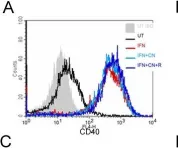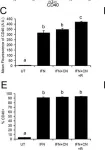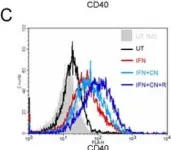The threat of new viral outbreaks has heightened the need for ready-to-use vaccines that are safe and effective. Here we show that a subcutaneous vaccine consisting of live Zika virus electrostatically entrapped in a self-adjuvanting hydrogel recruited immune cells at the injection site and provided mice with effective protection against a lethal viral challenge. The hydrogel prevented the escape of the viral particles and upregulated pattern recognition receptors that activated innate antiviral immunity. The local inflammatory niche facilitated the engulfment of the virus by immune cells infiltrating the hydrogel, the processing and cross-presentation of antigens and the expansion of germinal centre B cells and induced robust antigen-specific adaptive responses and immune memory. Inflammatory immune niches entrapping live viruses may facilitate the rapid development of safe and efficacious vaccines.
© 2023. The Author(s), under exclusive licence to Springer Nature Limited.
Product Citations: 18
Immunization against Zika by entrapping live virus in a subcutaneous self-adjuvanting hydrogel.
In Nature Biomedical Engineering on 1 July 2023 by Hao, H., Wu, S., et al.
-
Mus musculus (House mouse)
-
Immunology and Microbiology
In Science Advances on 28 April 2023 by Chen, Y. J., Li, G. N., et al.
Immune-responsive gene 1 (IRG1) encodes aconitate decarboxylase (ACOD1) that catalyzes the production of itaconic acids (ITAs). The anti-inflammatory function of IRG1/ITA has been established in multiple pathogen models, but very little is known in cancer. Here, we show that IRG1 is expressed in tumor-associated macrophages (TAMs) in both human and mouse tumors. Mechanistically, tumor cells induce Irg1 expression in macrophages by activating NF-κB pathway, and ITA produced by ACOD1 inhibits TET DNA dioxygenases to dampen the expression of inflammatory genes and the infiltration of CD8+ T cells into tumor sites. Deletion of Irg1 in mice suppresses the growth of multiple tumor types and enhances the efficacy of anti-PD-(L)1 immunotherapy. Our study provides a proof of concept that ACOD1 is a potential target for immune-oncology drugs and IRG1-deficient macrophages represent a potent cell therapy strategy for cancer treatment even in pancreatic tumors that are resistant to T cell-based immunotherapy.
-
FC/FACS
-
Mus musculus (House mouse)
-
Cancer Research
-
Immunology and Microbiology
In The Journal of Biological Chemistry on 1 December 2022 by Kumar Das, D., Zafar, M. A., et al.
Novel vaccination strategies are crucial to efficiently control tuberculosis, as proposed by the World Health Organization under its flagship program "End TB Strategy." However, the emergence of drug-resistant strains of Mycobacterium tuberculosis (Mtb), particularly in those coinfected with HIV-AIDS, constitutes a major impediment to achieving this goal. We report here a novel vaccination strategy that involves synthesizing a formulation of an immunodominant peptide derived from the Acr1 protein of Mtb. This nanoformulation in addition displayed on the surface a toll-like receptor-2 ligand to offer to target dendritic cells (DCs). Our results showed an efficient uptake of such a concoction by DCs in a predominantly toll-like receptor-2-dependent pathway. These DCs produced elevated levels of nitric oxide, proinflammatory cytokines interleukin-6, interleukin-12, and tumor necrosis factor-α, and upregulated the surface expression of major histocompatibility complex class II molecules as well as costimulatory molecules such as CD80 and CD86. Animals injected with such a vaccine mounted a significantly higher response of effector and memory Th1 cells and Th17 cells. Furthermore, we noticed a reduction in the bacterial load in the lungs of animals challenged with aerosolized live Mtb. Therefore, our findings indicated that the described vaccine triggered protective anti-Mtb immunity to control the tuberculosis infection.Copyright © 2022 The Authors. Published by Elsevier Inc. All rights reserved.
-
Mus musculus (House mouse)
-
Biochemistry and Molecular biology
-
Immunology and Microbiology
Pathogenic Leptospires Limit Dendritic Cell Activation Through Avoidance of TLR4 and TRIF Signaling.
In Frontiers in Immunology on 12 July 2022 by Cagliero, J., Vernel-Pauillac, F., et al.
Leptospira interrogans is a bacterial species responsible for leptospirosis, a neglected worldwide zoonosis. Mice and rats are resistant and can become asymptomatic carriers, whereas humans and some other mammals may develop severe forms of leptospirosis. Uncommon among spirochetes, leptospires contain lipopolysaccharide (LPS) in their outer membrane. LPS is highly immunogenic and forms the basis for a large number of serovars. Vaccination with inactivated leptospires elicits a protective immunity, restricted to serovars with related LPS. This protection that lasts in mice, is not long lasting in humans and requires annual boosts. Leptospires are stealth pathogens that evade the complement system and some pattern recognition receptors from the Toll-like (TLR) and Nod-Like families, therefore limiting antibacterial defense. In macrophages, leptospires totally escape recognition by human TLR4, and escape the TRIF arm of the mouse TLR4 pathway. However, very little is known about the recognition and processing of leptospires by dendritic cells (DCs), although they are crucial cells linking innate and adaptive immunity. Here we tested the activation of primary DCs derived from human monocytes (MO-DCs) and mouse bone marrow (BM-DCs) 24h after stimulation with saprophytic or different pathogenic virulent or avirulent L. interrogans. We measured by flow cytometry the expression of DC-SIGN, a lectin involved in T-cell activation, co-stimulation molecules and MHC-II markers, and pro- and anti-inflammatory cytokines by ELISA. We found that exposure to leptospires, live or heat-killed, activated dendritic cells. However, pathogenic L. interrogans, especially from the Icterohaemorraghiae Verdun strain, triggered less marker upregulation and less cytokine production than the saprophytic Leptospira biflexa. In addition, we showed a better activation with avirulent leptospires, when compared to the virulent parental strains in murine BM-DCs. We did not observe this difference in human MO-DCs, suggesting a role for TLR4 in DC stimulation. Accordingly, using BM-DCs from transgenic deficient mice, we showed that virulent Icterohaemorraghiae and Manilae serovars dampened DC activation, at least partly, through the TLR4 and TRIF pathways. This work shows a novel bacterial immune evasion mechanism to limit DC activation and further illustrates the role of the leptospiral LPS as a virulence factor.
Copyright © 2022 Cagliero, Vernel-Pauillac, Murray, Adler, Matsui and Werts.
-
Mus musculus (House mouse)
-
Immunology and Microbiology
Cancer cells dying from ferroptosis impede dendritic cell-mediated anti-tumor immunity.
In Nature Communications on 27 June 2022 by Wiernicki, B., Maschalidi, S., et al.
Immunogenic cell death significantly contributes to the success of anti-cancer therapies, but immunogenicity of different cell death modalities widely varies. Ferroptosis, a form of cell death that is characterized by iron accumulation and lipid peroxidation, has not yet been fully evaluated from this perspective. Here we present an inducible model of ferroptosis, distinguishing three phases in the process-'initial' associated with lipid peroxidation, 'intermediate' correlated with ATP release and 'terminal' recognized by HMGB1 release and loss of plasma membrane integrity-that serves as tool to study immune cell responses to ferroptotic cancer cells. Co-culturing ferroptotic cancer cells with dendritic cells (DC), reveals that 'initial' ferroptotic cells decrease maturation of DC, are poorly engulfed, and dampen antigen cross-presentation. DC loaded with ferroptotic, in contrast to necroptotic, cancer cells fail to protect against tumor growth. Adding ferroptotic cancer cells to immunogenic apoptotic cells dramatically reduces their prophylactic vaccination potential. Our study thus shows that ferroptosis negatively impacts antigen presenting cells and hence the adaptive immune response, which might hinder therapeutic applications of ferroptosis induction.
© 2022. The Author(s).
-
FC/FACS
-
Cancer Research
-
Immunology and Microbiology
In J Neuroinflammation on 6 March 2009 by Lin, H. W., Jain, M. R., et al.
Fig.5.A

-
FC/FACS
-
Mus musculus (House mouse)
Collected and cropped from J Neuroinflammation by CiteAb, provided under a CC-BY license
Image 1 of 4
In J Neuroinflammation on 6 March 2009 by Lin, H. W., Jain, M. R., et al.
Fig.5.C,E

-
FC/FACS
-
Mus musculus (House mouse)
Collected and cropped from J Neuroinflammation by CiteAb, provided under a CC-BY license
Image 1 of 4
In J Neuroinflammation on 6 March 2009 by Lin, H. W., Jain, M. R., et al.
Fig.6.A,C,E,G

-
FC/FACS
-
Mus musculus (House mouse)
Collected and cropped from J Neuroinflammation by CiteAb, provided under a CC-BY license
Image 1 of 4
In J Neuroinflammation on 6 March 2009 by Lin, H. W., Jain, M. R., et al.
Fig.6.C

-
FC/FACS
-
Mus musculus (House mouse)
Collected and cropped from J Neuroinflammation by CiteAb, provided under a CC-BY license
Image 1 of 4



